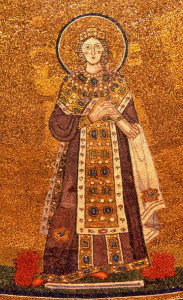Friends last night took Seth and me to the Kravis Center in West Palm Beach for a concert by the Budapest Festival Orchestra. I went knowing nothing about the Budapest Festival Orchestra or what would be on the program. The first two pieces were by Mozart, and they were good, certainly. The second half, though, was Felix Mendelssohn, who is more my speed. It was A Midsummer Night’s Dream, and it felt just about perfect to hear this now. I am still at the press every chance I get, working on my annual Copperman’s Day print, and usually listening to old obscure Christmas carols while I do so, for Copperman’s Day is the last of the odd “Goodbye to Yuletide” holidays. But even as I do so, the days are getting longer as we progress further and further from Midwinter’s longest night and toward Midsummer’s longest day. Here we are at the 21st of January, and it’s been one full month now of days lengthening since that shortest day. Each passing day adds a few minutes more daylight as the sun continues to trek further north in the sky. Sometimes we are given precisely what we need (even without realizing we needed it), and last night, Mendelssohn’s Midsummer Night’s Dream was just that thing.
Copperman’s Day was the Monday after Epiphany but I’ll keep working on that print until it’s done. Tonight, though, it’s another obscure old holiday, St. Agnes Eve, with its own traditions. It is a night of divination of a particular sort: a night when young girls could expect to see visions of their future loves. In Scotland, the tradition is to throw grain onto the soil of a field at midnight while reciting the following words:
Agnes sweet and Agnes fair,
Hither, hither, now repair;
Bonny Agnes, let me see
The lad who is to marry me.
The spells vary far and wide. In Italy, young girls go to bed without supper in order to dream of their future husbands. (One might wonder if this is worth it. I, for one, would be more content going to bed sated while dreaming of other things than a future love.) In other places, one must walk backwards to bed or bake a cake or eat a hard boiled egg before bed, yolk removed, the cavity filled with salt. Your future husband will, they say, bring you water in a dream. But of course you’d be dreaming of water to drink if you ate all that salt in one sitting.
John Keats in 1820 wrote a long poem titled “The Eve of St. Agnes” and in it, he put to paper many of these old traditions.
They told her how, upon St. Agnes’ Eve,
Young virgins might have visions of delight,
And soft adorings from their loves receive
Upon the honey’d middle of the night.
St. Agnes, like St. Valentine that follows soon after her, focuses on romance and matters of the heart, things that help melt the chill of winter. Like a surprise performance of A Midsummer Night’s Dream, St. Agnes warms the heart and the night.
Image: Saint Agnes, from the Basilica of Sant’Agnese Fuori le Mura in Rome.

You might be interested to know that here in Scotland Agnes is a common first name, and so is the name Senga (Agnes spelled backwards). I don’t know of other names which have backwards variants.
As always, very interesting John. The title and Keats comments have a way of giving you a vision of that night of dreams. And as for the days getting longer, we in the Midwest look forward to this as well as some sunshine. I’m tired of taking Vitamin D.
Thanks as always for the inspirational information!
G